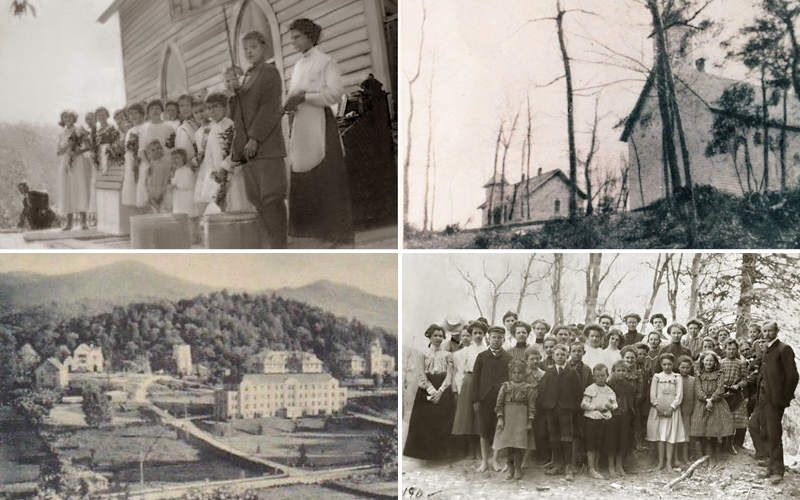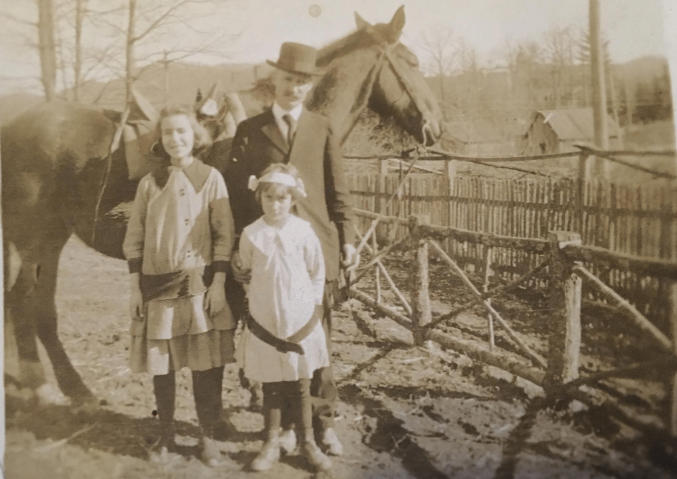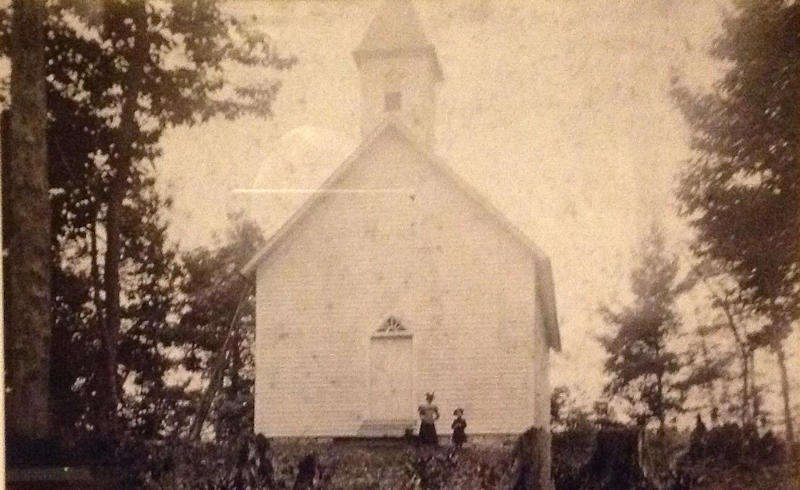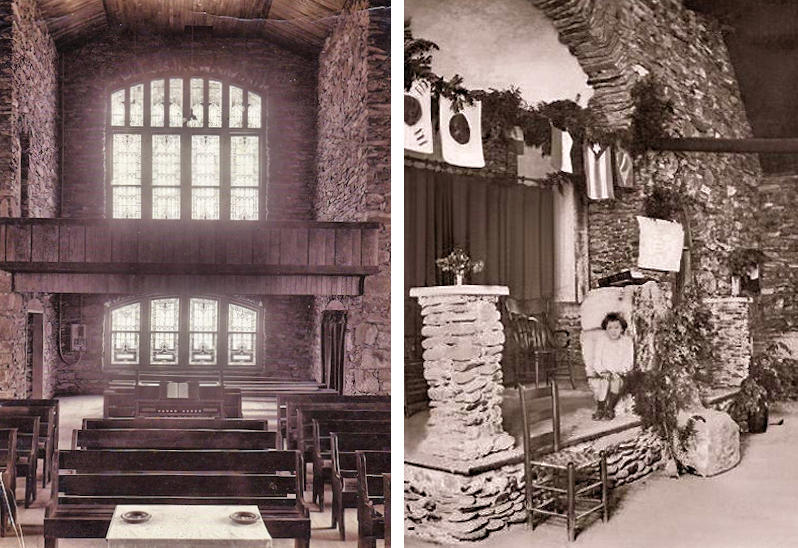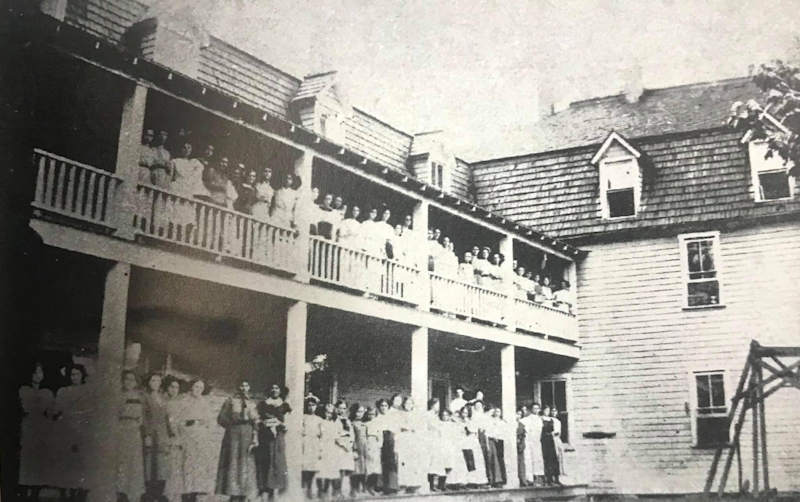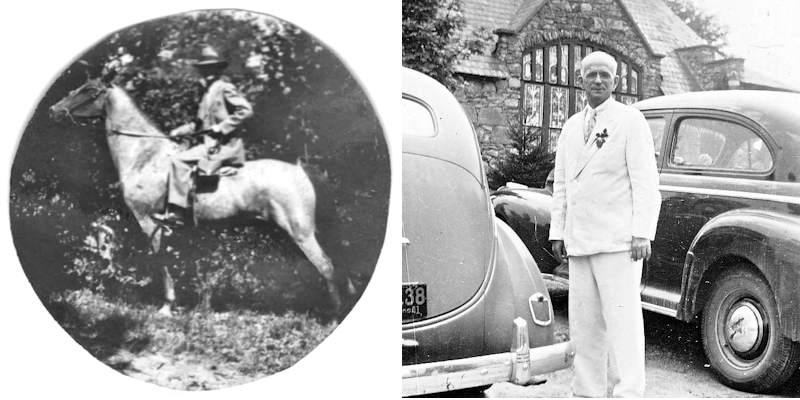Since its earliest beginnings, Banner Elk Presbyterian Church has had an interesting history, rich in service and ministry. The church dates its beginning to October 15, 1893 when 22 people made their professions of faith in response to the preaching mission of a Presbyterian evangelist, Rev. Dr. Robert P. Pell.
Rev. Pell, evangelist of the Presbytery of Concord, was assigned to Mitchell and Watauga counties by the Synod of North Carolina in 1891. He was minister at Spruce Pine when he was asked by Patsy Banner Witmore to come to Banner Elk to preach. He held a revival meeting in the Methodist Church. There had been no Methodist minister for three years, so that congregation joined the services. Rev. Pell worked in the area until 1895.
During the summers of 1895-1897, a young seminary student, Edgar Tufts (1869-1923), assisted in mission activities in a wide mountain area which included Banner Elk. He was sent from the Union Seminary in Hampden-Sidney, Virginia, to take charge of the Home Mission work in Watauga County.
Seldom in good health, Rev. Tufts was a small man who probably had tuberculosis three times. But he had an energy that defied physical prowess. His daughter, Margaret Tufts Neal, would say, “First he saw a need.” He saw impoverished young girls in need of education, so he created a school for girls – unheard of in those times. He saw abandoned children in need of refuge and created a home. He saw people in the mountains in need of a doctor and clinic, both of which he provided. All this while he led the Banner Elk Presbyterian Church.
Edgar was an itinerate minister as well, and until his death, continued to travel as far as Blowing Rock where he preached at Rumple Memorial, sometimes riding up on his horse unrecognizable, totally covered with ice and snow. Parishioners would bring out hot water to free his feet from the stirrups. He also preached at Linville, Pineola and Cove Creek.
With his encouragement and supervision, the first Presbyterian Church building in Banner Elk, said to be one of the “prettiest little churches” of its kind ever seen, was completed and dedicated in August 1896.
When he graduated from seminary, Rev. Tufts returned in May 1897 with his bride, Mary Elizabeth Hall (1874-1958), as Evangelist for Watauga County, which then included Banner Elk. Avery was formed in 1911. He was pastor of Banner Elk Church as well as the other churches. He later added Newland.
“Miss Bessie” brought her piano from Virginia – the first in Banner Elk. For many years, she guided congregations in singing, taught children to play and sing – her ministry of music. Read about the Tufts traveling pump organ.
Equally important to his service to churches, Tuft had an unrelenting interest in education, the physical welfare of mountain residents and the welfare of homeless children.
As church membership grew, Tufts shared his dream of building a church of native stone in Banner Elk. Many of the local mountain men were skilled in stone-craft, but rockwork previously had been used only for chimneys and foundations. Nowhere in the immediate area had the beautiful and plentiful native stone been used for an entire building. See the original architectural drawings.
The congregation was small in number and material wealth, but great in faith and dedication. Offers for materials and labor came from many sources, and much work went to raising funds to purchase property and begin construction in 1912.
Stories are still told of the community spirit which developed as local residents of all denominations assisted in the church construction, coming together each Saturday to help with the “new” idea of using plentiful native stone, instead of wood, to construct the building. Men and older boys hauled loads of big rocks from their farms and the river in wagons, which were often pulled by oxen. Children, including those who lived at Grandfather Home, carried water and collected piles of small rocks to be used in the cement.
The children, knowing they were assisting in important work, also found creative ways to earn and save pennies. Each week women brought brimming picnic baskets of food and generously contributed their energy and talents to help with the many tasks required. The multi-year building of the church became quite a community event as everyone eagerly joined in the work.
Two large puddingstone slabs were hauled up from the Elk River to be set into the front outside walls. These rare, unusual stones are estimated to be a billion years old, made of small rounded field stone of varying kinds and colors, held together by fine cement-like sand carried during the Ice Age by glaciers. Early settlers in the area thought the formations resembled European Christmas pudding.
The native-stone building was finished in 1915, complete with beautiful stained glass windows, the first that many people had ever seen. When the windows arrived in Elk Park on the Tweetsie train, ox-drawn wagons brought them to the church. Many people took picnic lunches to witness the spectacle. The bell in the tower was installed the following year.
There are several versions of how the stone pulpit was discovered by a logger in the deep woods on Beech Mountain. Stories agree that the stone was “meant to be” part of the new church which was being constructed in Banner Elk.
Local men, with the help of a logging sled drawn by oxen, hauled the mighty stone eight miles through rugged mountain terrain down to the site of the church. The stone pulpit, completely in its natural state, was firmly set in concrete on the ground under the new building and the floor of the sanctuary was built around it. Later, a smooth rock slab was set on top to hold the Bible. Read more about the stone pulpit.
Early on, the church sought to minister to the varied needs of the people in this area as well as to provide for rich Christian nurture and spiritual growth. As soon as the church was established, its work extended to include several nearby outreach locations, including Beech Mountain, Pigeon Roost, Hanging Rock Chapel, and an active Sunday school at the foot of Bald Mountain which became Arbor Dale Presbyterian Church.
When Rev. Tufts saw a need, he did not stop until he found a solution and the much needed funding. He introduced preserving ice by cutting it from the Millpond and storing the ice blocks in sawdust-filled ice houses. He also had a dam built on the Elk River to bring electricity to Banner Elk in 1912.
In 1942, a major renovation of the sanctuary took place to insulate against the cold weather. The inside rock walls were covered in insulation and wormy chestnut lumber, probably milled on site. During the early 1900s, a blight killed the American chestnut trees. The trees had great strength and remained standing – but insects bored into the wood, leaving holes and discoloration. The strong wood was readily available at the time. Today, wormy chestnut is very rare and in great demand by craftspeople.
Throughout the years, the original stone church building has been enlarged and renovated many times as the congregation has sought to meet ever-changing needs. The educational building was added in the 1950s. The Lewis & Hitchcock pipe organ was installed in 1993. A major expansion and renovation of classrooms and office areas were completed in 2003. The fellowship hall and kitchen were remodeled and refurbished in 2013.
Education
Rev. and Mrs. Tufts found many eager young minds with no opportunities for education, so they invited youth to their home to read. Next, they began a one room school in their attic. Word about the “preacher’s school” spread across the mountains with requests for a boarding school. In 1900, the first dormitory opened and “Lees-McRae Institute” began with 12 girls.
As Rev. Tufts traveled and visited families in the mountains, his heart was burdened with the numerous orphans he met. Thus, the Grandfather Orphanage was established in 1914, later becoming Grandfather Home for Children and operating until 2022.
In December 1922, Rev. Tufts rode horseback through the very cold and snowy mountains to Blowing Rock to preach. Along the way, he delivered warm clothes and provisions to four isolated elderly women at Grandfather Mountain. When he returned home on Christmas Day, he had a cold which turned into pneumonia. He died at the age of 53 on January 6. He had survived two earlier bouts with tuberculosis.
Medical Care
The first physicians in Banner Elk were recruited by Tufts. He met William Cummings Tate (1886-1960), a young doctor at the lumber camp. Tufts was later impressed when Tate played the organ at Pineola Presbyterian and a strong friendship began. Dr. Tate and his bride, Maude Malcolm (1887-1971), moved to Banner Elk from Knoxville in 1910. He became one of most beloved and trusted saddle-bag doctors in western North Carolina – and a leader in the church. On many winter nights when Dr Tate returned home on his horse, his wife had to go outside and pour hot water over his feet which had frozen in the stirrups.
Dr. Tate answered calls at any hour. He set up two rooms for patients in his home. Mrs. Tate often provided a meal or overnight bed for patients’ families. Rev. Tufts made multiple trips to New York to secure donations for larger medical facilities. In 1924, a fireproof hospital with 25 beds was dedicated near the church, serving nine mountain counties. Today, it is Tate Dorm at Lees-McRae College.
Dr. William Tate making house calls on horseback in 1910s (left) and Dr. Tate in the 1940s at the church
Dr. Tate and Rev. Tufts worked together to provide medical care for the mountain area, adapting to needs as time passed. A nurses’ training program taught local women important skills to help the hospital and its services grow. The first hospital, begun by Rev. Tufts and served by Dr. Tate, continued to minister to the community, building new facilities and providing more medical services.
Photo: William C. Tate (far right on front row) and Ronda H. Hardin (third from right on front row) led the staff at Grace Hospital in the 1930’s. Byron Pritchett, the hospital’s laboratory technician, is in the front row wearing a white coat and necktie. Behind and to his left, is Mary Chappell, a senior nurse on the hospital staff. Pauline Lawrence, a nurse anesthetist, is to Chappell’s left.
Rev. Tufts believed that the church’s mission should encompass not only preaching and teaching, but also healing and sheltering, as seen in his commitment to building not just our church, but the foundations for Lees-McRae College, Grandfather Home for Children and Cannon Memorial Hospital – in addition to other non-profits created to help residents in need. This mission continued through generations as Banner Elk Presbyterian Church supports and partners in many areas of ministry.
Pastors of BEPC
Rev. Dr. Robert Pell, Founder & Visiting Evangelist: 1893-1895
Rev. Edgar Tufts, Pastor: 1895-1923
Rev. T. H. Spence, Pastor: 1924-1929
Rev. Marion J. Murray, Pastor: 1931-1940
Rev. Thompson B. Southall, Pastor: 1941-1946
Rev. Lacy I. Moffett, Stated Supply: 1947-1950
Rev. Howard B. Foran, Stated Supply: 1951-1951
Rev. Daniel R. Thomas, Pastor: 1952-1964
Rev. Walter Keys, Stated Supply: 1965-1966
Rev. James N. Murry, Pastor: 1966-1979
Richard Peterson-Davis, Youth Worker: 1978-1980
Rev. Ragland Fletcher, Interim Pastor: 1980-1980
Rev. Richard Gale McGarry, Pastor: 1980-1985
Rev. Bobby Dean, Interim Pastor: 1986
Rev. John Thomas Phillips, Pastor: 1986-2004
Rev. Susan Rice, Associate Pastor: 1998-2001
Rev. Tyler Martin, Interim Pastor: 2004-2005
Rev. Dr. Joseph D. Washburn, Pastor: 2005-2011
Rev. Theophilus Feild Russell, Interim Pastor: 2012-2013
Rev. Theophilus Feild Russell, Pastor: 2013-2019
Rev. Dr. Edward Donnell, Bridge Interim Pastor: 2019
Rev. J. Dechard Guess, Interim Pastor: 2019-2021
Rev. Rachael McConnell, Pastor: 2021-2022
Rev. Dr. Whit Malone, Interim Pastor: 2022-2024
Rev. Lance Perry, Interim Pastor: 2024-
Today, this friendly, dedicated, inclusive church family consists of both full-time and seasonal members from various backgrounds and faith traditions. Members work in unity of spirit and in deep commitment to share energy, resources and enthusiasm in serving needs locally, nationally and globally. Read about our current ministries and ways we are helping in our community.
Click the following links to learn more about our history:

